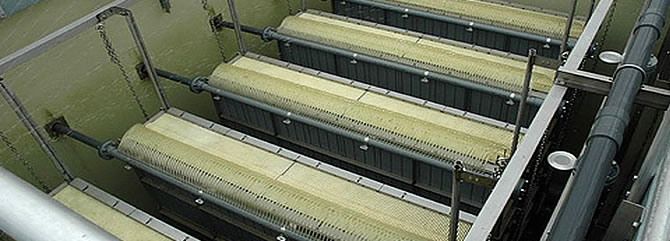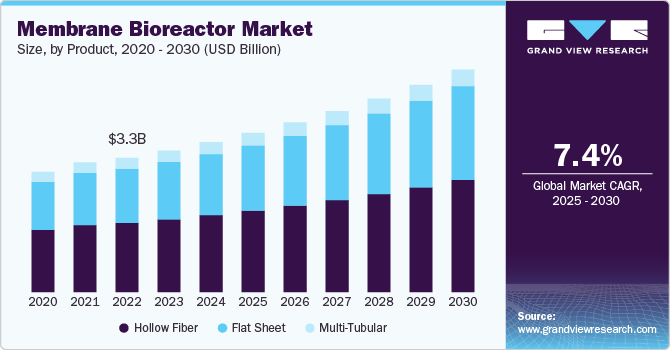Membrane Bioreactor as a Sustainable Solution for High-Volume Wastewater Treatment
Membrane Bioreactor as a Sustainable Solution for High-Volume Wastewater Treatment
Blog Article
How Membrane Layer Bioreactors Are Changing Water Purification Systems
The development of membrane layer bioreactors (MBRs) stands for a substantial innovation in the field of water filtration, merging organic treatment processes with advanced membrane filtration modern technologies. This integration not just enhances the top quality of dealt with effluent but also addresses urban area constraints, making MBRs specifically suitable for densely inhabited areas. As global water shortage magnifies, the function of MBRs in promoting drinkable water reuse and sustainable water monitoring comes to be progressively important. Yet, the implications of this modern technology extend past efficiency-- what challenges and opportunities exist ahead for its widespread execution?
Review of Membrane Bioreactors
Membrane bioreactors (MBRs) represent a considerable innovation in water purification modern technology, as they incorporate biological therapy procedures with membrane layer filtration. This assimilation enhances the performance of wastewater therapy by utilizing bacteria to weaken organic toxins while at the same time using semi-permeable membranes to separate treated water from suspended solids and microorganisms.
The MBR system usually includes a biological activator where the microbial population metabolizes contaminants, adhered to by a membrane layer filtering device that retains biomass and permits only tidy water to pass through. This twin performance causes greater effluent high quality compared to traditional therapy methods. MBRs can be operated in both batch and continual circulation modes, providing flexibility in style and application.
Additionally, MBRs are defined by their compact impact, making them ideal for city setups with space restraints. Membrane Bioreactor. They additionally allow the recuperation of water for reuse, therefore adding to water sustainability campaigns. While MBR innovation has gotten popularity in municipal and industrial applications, its functional complexities and power demands necessitate mindful factor to consider throughout application. Overall, MBRs are at the center of enhancing water therapy performance and high quality, showcasing the capacity for cutting-edge solutions in ecological administration.
Advantages of MBR Technology
The integration of biological therapy with membrane layer purification provides many advantages for water purification processes. Among the primary advantages of Membrane layer Bioreactor (MBR) technology is its capability to effectively eliminate both inorganic and organic contaminants, leading to top quality effluent. The membrane layers act as a physical barrier, stopping put on hold solids and pathogens from passing through, which improves the general security and reliability of treated water.
Additionally, MBR systems need a smaller sized footprint compared to conventional treatment methods, permitting more reliable room application. This compact style is especially beneficial in urban setups where land is restricted. MBRs additionally show operational flexibility, suiting differing influent qualities and flow rates without considerable performance deterioration.
Additionally, the procedure provides enhanced nutrient removal capabilities, particularly for nitrogen and phosphorus, which are vital for preventing eutrophication in receiving waters. The minimized sludge production linked with MBR technology also equates to reduce disposal costs, making it a cost-efficient solution in the lengthy run - Membrane Bioreactor. Generally, the advantages of MBR modern technology placement it as a leading option for cutting-edge and sustainable water purification systems, attending to both ecological and financial problems
Applications in Water Purification
Applications of Membrane Layer Bioreactor (MBR) innovation in water filtration are diverse and impactful, resolving different treatment needs across numerous markets. MBRs efficiently integrate organic treatment procedures with membrane filtering, making them perfect for municipal wastewater treatment, commercial effluent management, and also drinkable water reuse efforts.
In local setups, MBRs are progressively used to improve the quality of dealt with wastewater, permitting for compliance with strict discharge policies and promoting the recycling of water for irrigation and non-potable uses. Their portable layout additionally makes them appropriate for city atmospheres where room is limited.
Industrially, MBR technology is made use of to treat process water and wastewater, particularly in fields such as food and beverage, drugs, and fabrics. By efficiently removing pollutants and put on hold solids, MBRs help industries go right here minimize environmental effects while recovering useful sources from wastewater streams.
Moreover, MBRs are acquiring traction in decentralized water treatment applications, where small-scale systems can be released in remote areas or establishing regions. This versatility enables communities to accomplish lasting water management services, boosting accessibility to clean water while lowering dependence on standard therapy approaches.
Case Research Studies and Success Stories

In an additional instance, a fabric manufacturing center in Bangladesh adopted MBR technology to address its wastewater obstacles. The system decreased chemical oxygen need (COD) degrees from 1,200 mg/L to less than 100 mg/L, hence meeting governing criteria and read this significantly minimizing ecological effect.
The University of Cape Community's MBR installation has actually verified effective in treating greywater for non-potable reuse on school. This project not just preserves drinkable water however likewise serves as an academic model for lasting methods.
Moreover, a fish and shellfish processing plant in Norway used MBR technology to deal with effluents having high degrees of raw material, attaining over 90% contaminant elimination. These situation research studies emphasize MBR innovation's flexibility and its vital duty in boosting water top quality across diverse applications.
Future of Water Therapy Solutions
As worldwide water deficiency and pollution obstacles magnify, cutting-edge water therapy remedies are coming to be progressively vital to ensure sustainable access to tidy water. The future of water therapy depends on the assimilation of sophisticated technologies that boost the efficiency and effectiveness of filtration procedures. Membrane layer bioreactors (MBRs) go to the leading edge of this development, combining organic therapy with membrane purification to produce top quality effluent ideal for numerous applications.

Arising fads such as source healing from wastewater, including nutrients and power, will certainly additionally transform treatment centers right into environment-friendly hubs. Additionally, developments in nanotechnology and membrane materials assure enhanced performance and long life of purification systems.

Conclusion
Their role in potable water reuse and lasting water monitoring highlights their importance in attending to worldwide water deficiency obstacles. Proceeded research study and growth will certainly further improve the effectiveness and adoption of MBR innovation, making sure a resistant future for water therapy solutions.
The development of membrane bioreactors (MBRs) stands for a substantial innovation in the field of water filtration, combining organic therapy procedures with sophisticated membrane layer purification modern technologies. As global water scarcity escalates, the role of MBRs in assisting in drinkable water reuse and lasting water administration ends up being progressively important. They additionally allow the recovery of water for reuse, thus contributing to water sustainability initiatives.As global water deficiency and air pollution obstacles escalate, cutting-edge water therapy remedies are coming to be significantly necessary to make sure sustainable accessibility to tidy water. Their function in drinkable water reuse and sustainable water monitoring highlights their importance in attending to worldwide water shortage challenges.
Report this page